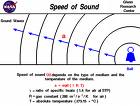
Waves exist in two forms– transverse (like an ocean wave) and longitudinal (like sound waves).

A transverse wave has a displacement perpendicular to the medium while the displacement of the medium in a longitudinal wave is parallel to the medium.
Thus an ocean wave goes up and down while sound waves compress the air in a parallel way towards the target.
Waves can be periodic, similar to simple harmonic motion, or a single pulse, similar to a pulse moving along a slinky.
And if someone asks you what’s nu, you can say v/lambda. (physics joke)
Leave a Reply